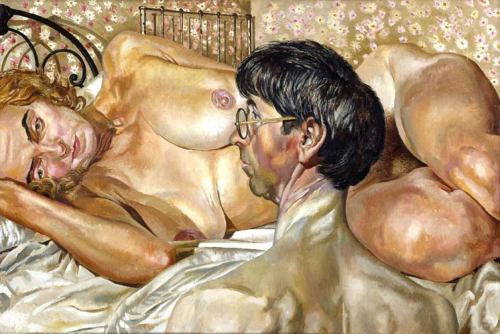The last week i've been restless trying to answer a simple, yet, rhetorical question: Is Stanley Spencer (1891-1959) a great artist? or rather: Does Stanley Spencer matter? The questions of this sort appear very challenging whenever you are trying to find an answer yourself, rather than to google the rating 'of the most important British Artists of the 20th century'.
The need of the definite answer is augmented by the fact that on June 15-17 the Evill/Frost Collection is on sale at Sotheby's London - simply 'the Greatest Collection of 20th-Century British Art Ever to Come to the Market'. Along with Spencer's paintings, this private collection comprises works by Lucian Freud, Henry Moore, Graham Sutherland, and al.
The need of the definite answer is augmented by the fact that on June 15-17 the Evill/Frost Collection is on sale at Sotheby's London - simply 'the Greatest Collection of 20th-Century British Art Ever to Come to the Market'. Along with Spencer's paintings, this private collection comprises works by Lucian Freud, Henry Moore, Graham Sutherland, and al.
 |
| Workmen in the House, 1935 |
In the vacuum art market the importance of the artist is positively correlated with the prices of his artworks. What implications can be derived from the £1.5-2.5 million estimate set by Sotheby's for 1935 "Workmen in the House"? Is Spencer undervalued? With Francis Bacon, traditionally referred to as a great British artist, reaching occasionally 44 million. So far, the highest price ever payed for Spencer was £1.3 million by a London dealer Ivor Braka, back in 1998. As Braka states himself, no one has outbidded him since then. So is Spencer unfairly cheap? Or do the prices fetched reflect correctly the number of pages devoted to him in the 'history of art' volume? Vicious circle, indeed. The connections between value and price have never been straightforward.
The aim set is to understand what is it about this boyish unkempt man painting both biblical scenes and embarrassingly revealing nudes that is important for the story of art of the 20th century. The prices are to follow.
The aim set is to understand what is it about this boyish unkempt man painting both biblical scenes and embarrassingly revealing nudes that is important for the story of art of the 20th century. The prices are to follow.
 |
| The Centurion's Servant. 1914 |
One thing is clear. Private life of Stanley is as well-known as his art, the statement not being insulting for the artist, since all his art was for himself and about himself. Spencer did not paint out of uncontrolled creativity, need of money, or desire to become famous. His curiosity and anxiety were pushing him forward, and art was the instrument to comprehend the world around, as well as his inner world. To paint was a vital necessity, because otherwise Stanley would stumble along his way.
Spencer did not go too far in geographical sense, he spent his life in small provincial Cookham and had a great chance to rest a regional-level artist; however he managed to go beyond parochial. Seeking for inspiration, Spencer left his first wife Hilda and married his Cookham neighbor, an elegant lesbian Patricia Preece - "the apparition in furs and heels amidst the walled gardens".The marriage proved to be disastrous, since Patricia refused Spencer to serve as his power source. Spencer had nothing to do but satisfy himself with platonic muse-artist relationship.
Spencer did not go too far in geographical sense, he spent his life in small provincial Cookham and had a great chance to rest a regional-level artist; however he managed to go beyond parochial. Seeking for inspiration, Spencer left his first wife Hilda and married his Cookham neighbor, an elegant lesbian Patricia Preece - "the apparition in furs and heels amidst the walled gardens".The marriage proved to be disastrous, since Patricia refused Spencer to serve as his power source. Spencer had nothing to do but satisfy himself with platonic muse-artist relationship.
 |
| Self-portrait with Patricia Preece, 1937 |
Spencer, who had dreams of relations with women similar to those of Marcello Mastroianni's hero in "8 1/2", pursued a goal of having two wives after he had married Patricia. When the realization of Stanley Spencer's artistic harem dream has failed, he could do nothing but have sex with Patricia in his visionary paintings, and stay in sexual correspondence with Hilda until her death, and strangely, even after her death. His paintings of this difficult period, are of the most comprehensive in their imagery, and yet in their iconography they are all related to sex, or better to say no sex, Cookham, religion, dogs and flowers. Spencer's frankness in those paintings sometimes exceeds the limits of my timidness (preventing me from posting the images), others looking very innocent, require a more profound gaze and consideration to reveal the same embarrassing exposing.
Did Spencer desire such level of openness or was it unintended result of his artistic process? Even though his most shocking works, namely nudes, were not sold, we know that he wanted them to be exhibited, and was greatly disappointed by Patricia'a reluctance. Exposing his own self in the paintings, Spencer has brought to a public his private fantasies and desires. As it appears he must have been quite egocentric and eccentric in putting his own 'I' as the main subject of conversation with the audience: 'Hallo! I am Stanley Spencer, here on my paintings you can see MY childhood problems, MY religious Victorian upbringing, MY religious philosophy, MY obsession with sex, flesh, and female body". "My chief and only occupation is with my own thoughts", said Spencer once.
Truthfulness about oneself, the most difficult kind of saying the truth, is definitely the artistic quality for which Stanley will not be forgotten.
Meanwhile, the sale of three Spencers is to come in June. The understanding of his art is yet to arrive.

No comments:
Post a Comment